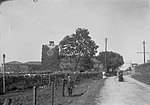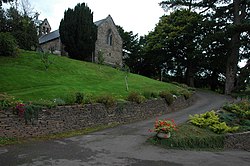Pandy railway station
Disused railway stations in MonmouthshireFormer Great Western Railway stationsPages with no open date in Infobox stationRailway stations in Great Britain closed in 1854Railway stations in Great Britain closed in 1958 ... and 1 more
Use British English from February 2022
Pandy railway station was a railway station which served the Monmouthshire village of Pandy. It was located on the Welsh Marches Line between Hereford and Abergavenny. The station, comprising a booking office, a cloakroom and the station-master's house, was destroyed by fire in 1904.The station closed in 1958. The Owen Sheers novel Resistance used Pandy railway station as a location.
Excerpt from the Wikipedia article Pandy railway station (License: CC BY-SA 3.0, Authors).Pandy railway station
A465,
Geographical coordinates (GPS) Address External links Nearby Places Show on map
Geographical coordinates (GPS)
| Latitude | Longitude |
|---|---|
| N 51.9008 ° | E -2.9651 ° |
Address
Pandy
A465
NP7 8DR , Crucorney
Wales, United Kingdom
Open on Google Maps










